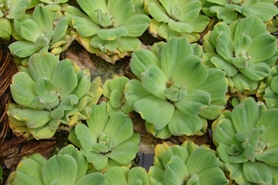Water lettuce
(Pistia stratiotes)
A floating perennial resembling a floating head of lettuce. It is disputed whether or not it is native to the United States since it was observed and documented in William Bartram’s 1765 explorations of Florida. It has high rates of vegetative reproduction, so it can rapidly form dense mats on the surface of water bodies.
Other names for this plant include:
- Common names: tropical duckweed
- Scientific names: Pistia spathulata
Classification in Wisconsin: Prohibited
- Ecological Threat
-
- It invades freshwater lakes, reservoirs, ponds, marshes, slow-flowing streams, and rivers, making boating, fishing, and almost all other water activities difficult.
- Degrades water quality by blocking the air-water interface and significantly reducing oxygen levels in the water, impacting underwater animals such as fish.
- Significantly reduces biological diversity: mats block sunlight, preventing the growth of submerged and emersed plant communities and also alter animal communities by blocking access to the water and lowering plants the animals depend on for shelter and nesting.
- Identification
-
Leaves: Soft and thick, formed in rosettes; have no leaf stems; leaves six in. long; light green; parallel ridges (veins); covered in short hairs; leaf margins wavy, top margins scalloped.
Flowers: Inconspicuous; nearly hidden in the center amongst the leaves; on a small stalk, single female flower below and whorl of male flowers above. Blooms in late summer to early winter.
Fruits & seeds: A green berry.
Roots: Hang submersed beneath floating leaves; feathery, numerous.
Similar species: Not likely to be confused with any other plant.
- Distribution
-
See the reported locations of water lettuce in Wisconsin.
Do you know of additional populations? Please send us a report.
- Control
-
Mechanical: Removal by hand or machine is a practical control method often used for small areas or when numbers are low. Physical removal should be completed before the flowering and seed set.
Chemical: Registered aquatic herbicides can temporarily control water lettuce in small-scale applications. The application of aquatic herbicide requires a permit.
Biological: Only two insects have been released into the United States as biological control agents against this weed; the South American weevil N. affinis and the Asian moth S. pectinicornis.
- Resources
- Sources for content:
- Bugwood Wiki Factsheet [exit DNR]
- The University of Florida Center for Aquatic and Invasive Plants: Factsheet [exit DNR]



